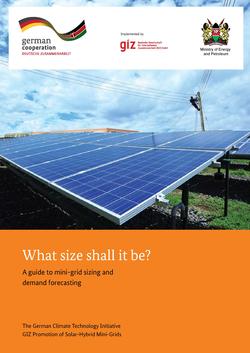Difference between revisions of "Mini-Grid Sizing"
***** (***** | *****) |
***** (***** | *****) |
||
| Line 35: | Line 35: | ||
2.1. Initial project assessment 22<br/> 2.2. Assessment of present electricity demand 23<br/> 2.3. Effective electricity demand and its calculations 28<br/> 2.4. Forecasting effective demand 32<br/> 2.5. System sizing and design 36<br/> 3. Tools for system sizing 43<br/><span style="font-size: 13.6px; background-color: rgb(255, 255, 255);"> </span>3.1 Overview of existing tools for system sizing 43<br/><span style="font-size: 13.6px; background-color: rgb(255, 255, 255);"> </span>3.2. Description of mini-grid builder 45<br/><span style="font-size: 13.6px; background-color: rgb(255, 255, 255);"> </span>3.3. Description of HOMER Energy 46<br/><span style="font-size: 13.6px; background-color: rgb(255, 255, 255);"> </span>4. Conclusion 50<br/> 5. Annex 51<br/><span style="font-size: 13.6px; background-color: rgb(255, 255, 255);"> </span>5.1. Required information for load assessment and system sizing 53<br/><span style="font-size: 13.6px; background-color: rgb(255, 255, 255);"> </span>5.2. Mini-grid builder 54<br/> Bibliography 66<br/> | 2.1. Initial project assessment 22<br/> 2.2. Assessment of present electricity demand 23<br/> 2.3. Effective electricity demand and its calculations 28<br/> 2.4. Forecasting effective demand 32<br/> 2.5. System sizing and design 36<br/> 3. Tools for system sizing 43<br/><span style="font-size: 13.6px; background-color: rgb(255, 255, 255);"> </span>3.1 Overview of existing tools for system sizing 43<br/><span style="font-size: 13.6px; background-color: rgb(255, 255, 255);"> </span>3.2. Description of mini-grid builder 45<br/><span style="font-size: 13.6px; background-color: rgb(255, 255, 255);"> </span>3.3. Description of HOMER Energy 46<br/><span style="font-size: 13.6px; background-color: rgb(255, 255, 255);"> </span>4. Conclusion 50<br/> 5. Annex 51<br/><span style="font-size: 13.6px; background-color: rgb(255, 255, 255);"> </span>5.1. Required information for load assessment and system sizing 53<br/><span style="font-size: 13.6px; background-color: rgb(255, 255, 255);"> </span>5.2. Mini-grid builder 54<br/> Bibliography 66<br/> | ||
| + | |||
| Line 43: | Line 44: | ||
<br/> | <br/> | ||
| − | Link | + | Link [[File:Mini-Grid Sizing Guidebook.pdf|thumb|left|250pxpx|Mini-Grid Sizing Guidebook.pdf]] |
Revision as of 12:57, 7 October 2016
What size shall it be?
A guide to mini-grid sizing and demand forecasting
How to assess the electricity demand for a community and determine the appropriate size of a new solas mini-grid
August 2016
GIZ ProSolar - Promotion of Solar Hybrid Mini-Grids Project
Foreword
This handbook has been developed as part of a series of handbooks on minigrids. After the publication of handbooks on site selection (“Where shall we put it?”) and licensing (“How do we license it?”) this handbook on load assessment and mini-grid system sizing is the third publication in the series. While the first two handbooks focused on the Kenyan context, this handbook is applicable to all the various geographical contexts where mini-grids can be implemented. Practical knowledge has been drawn from the authors’ experience in mini-grid implementation in sub-Saharan Africa.
Most of the content of this handbook has general validity for load assessment and system sizing. However, the methodology for the actual sizing (Chapter 2) is based on the approach of the mini-grid builder, an online tool developed by GIZ ProSolar in 2015, based on the experiences made with load assessment and system sizing of a pilot solar-hybrid mini-grid in Talek, Narok County (Kenya). It should be noted that this is just one viable approach for system sizing, some others being mentioned in Chapter 3.
Adequate load assessment and demand forecast, as well as subsequent system sizing, is essential for the appropriate design of mini-grids. The economic viability of mini-grid projects depends on the size of the installed assets — and thus the investments — which need to be backed by a payable demand in the years after commissioning. A wrongly configured system (too small or too large) will either not serve its purpose or not recover the costs required to set it up. We thus deem it highly important to discuss demand assessment and mini-grid sizing in this handbook.
As it is easier to determine the size for capacity additions to existing schemes (e.g. hybridisation of existing diesel mini-grids with solar), this handbook focuses on the more challenging case of load assessment and sizing for new mini-grids in areas without electricity. Such ‘greenfield’ sites represent the larger share in terms of rural electrification opportunities. Furthermore, as solar-hybrid minigrids are often the most viable set-up in the sub-Saharan context, the main focus of this handbook is on these systems.
While this handbook intends to display the required knowledge for systems sizing and demand forecast, mini-grid projects are very site specific. The authors of this handbook therefore do not accept any liability for commercial or investment decisions taken on the grounds of the knowledge presented within. It is recommended to always conduct a proper due diligence and closely collaborate with an expert to configure mini-grid systems appropriately.
Table of contents
- Introduction 13
1.1. Prospects for rural electrification 13
1.2. Mini-grids and the relevance of accurate system sizing 15
2. Sizing a mini-grid 20
2.1. Initial project assessment 22
2.2. Assessment of present electricity demand 23
2.3. Effective electricity demand and its calculations 28
2.4. Forecasting effective demand 32
2.5. System sizing and design 36
3. Tools for system sizing 43
3.1 Overview of existing tools for system sizing 43
3.2. Description of mini-grid builder 45
3.3. Description of HOMER Energy 46
4. Conclusion 50
5. Annex 51
5.1. Required information for load assessment and system sizing 53
5.2. Mini-grid builder 54
Bibliography 66
References
The German Climate and Technology Initiative GIZ ProSolar – Promotion of Solar-Hybrid Mini-Grids in Kenya. What size shall it be? Nairobi. August 2016
Link




















